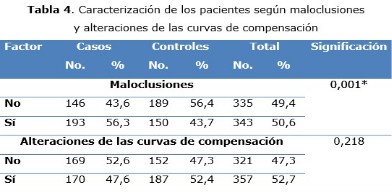Risk factors of bruxism in adult patients
Keywords:
BRUXISMO, OCLUSIÓN DENTARIAAbstract
Background: among the parafunctional alterations, bruxism is the most prevalent, complex and destructive of the orofacial disorders.
Objective: to determine the risk factors of bruxism in adult patients assisted in the dental occlusion service consultation.
Methods: an analytical study of control-cases was carried out from January 2014 to July 2016, from a universe of 2 000 patients, by means of a simple random sampling. The selection of the sample was composed of 678 individuals, divided in two groups: a study group and a control group, integrated by 339 patients each one. The associations between the alleged risk factors and the occurrence of bruxism were evaluated by unvaried and multivaried logistic regression.
Results: there was a risk relationship between bruxism and stress, the resource of facing stress with a negative focalization, the smoking habit, occlusive interference and malocclusion.
Conclusions: the possibility of being a bruxist patient was determined in relation to the included variables and estimated the independent influence of each variable over bruxism when controlling the rest of them.
DeCS: BRUXISM/etiology; RISK FACTORS; DENTAL OCCLUSION; ADULT; CASE-CONTROL STUDIES.
Downloads
References
1. Pieri Silva K, Mora Pérez C, Álvarez Rosa I, González Arocha B, García Alpízar B, Morales Rosell L. Resultados de tratamiento estomatológico en niños con bruxismo. Medisur [Internet]. Feb 2015 [citado 11 Ene 2016];13(1):[aprox. 5 p.]. Disponible en: http://scielo.sld.cu/scielo.php?script=sci_arttext&pid=S1727-897X2015000100014&lng=es
2. Silva Contreras AM. Bruxismo: su comportamiento en un área de salud. Rev Cienc Méd [Internet]. Ene-Feb 2015 [citado 18 Ene 2016];19(1):[aprox. 9 p.]. Disponible en: http://scielo.sld.cu/scielo.php?script=sci_arttext&pid=S1561-31942015000100009&lng=es
3. Montero Parrilla JM, Jiménez Quintana Z. Rehabilitación ocluso-articular en un paciente bruxópata. Rev Cub Estomatol. 2011;48(3):287-92.
4. Díaz Gómez SM. Texto de parafunciones en sistema braille para pacientes ciegos y de baja visión. Arch Méd Camagüey [Internet]. Mar-Abr 2016 [citado 9 May 2016];20(2):[aprox. 9 p.]. Disponible en: http://www.revistaamc.sld.cu/index.php/amc/article/view/4303
5. De la Torre Rodríguez E, Aguirre Espinosa I, Fuentes Mendoza V, Peñón Vivas PA, Espinosa Quirós D, Núñez Fernández J. Factores de riesgo asociados a trastornos temporomandibulares. Rev Cub Estomatol [Internet]. Sep-Dic 2013 [citado 18 Nov 2015];50(4):[aprox. 9 p.]. Disponible en: http://scielo.sld.cu/scielo.php?script=sci_arttext&pid=S0034-75072013000400004&lng=es
6. Guevara Gómez SA, Ongay Sánchez E, Castellanos Suárez JL. Avances y limitaciones en el tratamiento del paciente con bruxismo. Rev ADM. 2014;72(2):106-14.
7. Cordero García S, Peña Sisto M. Factores de riesgo de hipersensibilidad dentinaria en pacientes adultos con prótesis dental. MEDISAN [Internet]. Mar 2012 [citado 28 Abr 2016];16(3):[aprox 8 p.]. Disponible en: http://scielo.sld.cu/scielo.php?script=sci_arttext&pid=S1029-30192012000300006&lng=es
8. Barber Gutiérrez R, González González G, Robledo Fernández M, de los Santos Solana L. Principios Biomecánicas de la Prótesis Parcial Removible. En: González González G, Ardanza Zulueta P, editores. Rehabilitación protésica estomatológica. La Habana: Editorial Ciencias Médicas; 2008. p. 139.
9. Rodríguez Perón JM, Aldana Vilas L, Villalobos Hevia N. Método Delphi para la identificación de prioridades de ciencia e innovación tecnológica. Rev Cub Méd Mil [Internet]. Jul-Dic 2010 [citado 16 Feb 2015];39(3-4):[aprox. 12 p.]. Disponible en:http://scielo.sld.cu/scielo.php?pid=S013865572010000300006&script=sci_arttext
10. Leyva Ponce de León A, Escalona Silva Y. Caracterización clínico epidemiológica del Bruxismo en pacientes mayores de 15 años. Rev Electrón Dr Zoilo E Marinello Vidaurreta [Internet]. Nov 2013 [citado 8 Jun 2015];38(11):[aprox. 7 p.]. Disponible en: http://www.ltu.sld.cu/revistam/modules.php?name=News&file=article&sid=725
11. Alcolea Rodríguez JR, Herrero Escobar P, Ramón Jorge M, Labrada Sol ET, Pérez Téllez M, Garcés Llauger D. Asociación del bruxismo con factores biosociales. CCM [Internet]. Abr-Jun 2014 [citado 8 Jun 2015];18(2):[aprox. 9 p.]. Disponible en: http://scielo.sld.cu/scielo.php?script=sci_arttext&pid=S1560-43812014000200003&lng=es
12. Delgado Izquierdo Y, González Olazábal MV, Pérez García LM, Barreto Ortega MA. Influencia de la guía incisiva en personas con trastornos temporomandibulares Área Norte de Sancti Spíritus. Gac Méd Espirit [Internet]. Ene-Abr 2015 [citado 25 Ene 2016];17(1):[aprox. 10 p.]. Disponible en: http://scieloprueba.sld.cu/scielo.php?script=sci_arttext&pid=S1608-89212015000100002&lng=es
13. Cárdenas Eroza R, Mendiburu Zavala CE, Cortes Carrillo D, Navarro Zapata D, Lugo Ancona P. Guía Anterior como factor etiológico del dolor de la articulación temporomandibular. Intra Med Journal. 2012;1(3):1-6.
14. Ahlberg J, Lobbezoo F, Ahlberg K, Manfredini D, Hublin CH, Sinisalo J, et al. Self-reported bruxism mirrors anxiety and stress in adults. Med Oral Patol Oral y Cir Bucal. 2013;18(3):7-11.
15. Nápoles García D, García Cabrera L, Rodríguez Reyes O, Nápoles Méndez D. Tendencias contemporáneas de las bases fisiopatológicas del bruxismo. MEDISAN [Internet]. Ago 2014 [citado 28 Oct 2015];18(8):[aprox. 7 p.]. Disponible en: http://scielo.sld.cu/scielo.php?script=sci_arttext&pid=S1029-30192014000800017&lng=es
16. Okenson JP. Etiología de los trastornos funcionales del sistema masticatorio. En: Okenson JP, editor. Tratamiento de Oclusión y afecciones temporomandibulares. 3rª ed. Barcelona: Mosby; 2010. p. 170.
17. Maddalena Dias I, Marins Ramalho de Mello L, Duque Maia I, de Oliveira Reis L, Gonçalves Leite IC, Pessôa Pereira Leite F. Avaliação dos fatores de risco do bruxismo do sono. Arq Odontol [Internet]. Sep 2014 [citado 29 May 2015];50(3):[aprox. 12 p.]. Disponible en: http://revodonto.bvsalud.org/scielo.php?script=sci_arttext&pid=S1516-09392014000300002&lng=es&nrm=iso
18. Verdugo-Lucero JC, Ponce de León-Pagaza BG, Guardado-Llamas RE, Meda-Lara RM, Uribe-Alvarado J, Isaac Guzmán-Muñiz J. Estilos de afrontamiento al estrés y bienestar subjetivo en adolescentes y jóvenes. Rev Latinoam Cienc Soc Niñez Juv. 2013;11(1):79-91.
19. García Gascón Á, Querts Méndez O, Hierrezuelo Izquierdo EJ, Quesada Vidal S. Algunos aspectos psicosociales del insomnio en estudiantes de primer año de medicina. MEDISAN [Internet]. Ene 2015 [citado 5 May 2015];19(1):[aprox. 4 p.]. Disponible en: http://scieloprueba.sld.cu/scielo.php?script=sci_arttext&pid=S1029-30192015000100009&lng=es
20- AEPap.org [Internet]. Madrid: Grupo de Sueño de la AEPap; c1999-2016. [actualizado 15 Ene 2012; citado 5 Jun 2016]. Exposición al humo del tabaco y bruxismo; [aprox. 2 pantallas]. Disponible en: http://www.aepap.org/gtsiaepap/?p=892
21. Grau León I, Cabo R. Evaluación de la oclusión en pacientes con trastornos temporomandibulares y desarmonías oclusales. Rev Cub Estomatol [Internet]. Jun 2010 [citado 15 Oct 2015];47(2):[aprox. 6 p.]. Disponible en: http:// scielo.sld.cu/scielo.php?script=sciarttext&pid=S003475072010000200005&lng=es
22. Ruiseco Palomares A, Llanes Rodríguez M, Rodríguez Calzadilla OL, Rodríguez Aparicio A. El dolor articular y su relación con las interferencias oclusales. Rev Haban Cienc Med [Internet]. May-Jun 2014 [citado 15 Oct 2015];13(3):[aprox. 7 p.]. Disponible en: http://scielo.sld.cu/scielo.php?script= sci_arttext&pid=S1729519X2014000300007&lng = es
23. Castillo Hernández R. Nuevas Variables para el Tratamiento Oclusal y Prevención de la Disfunción Temporomandibular [tesis doctoral]. Villa Clara: ISCM “Serafín Ruiz De Zárate”, Facultad de Estomatología; 2007 [citado 15 Oct 2015]. Disponible en:
http://tesis.repo.sld.cu/409/1/Tesis_doctoral-Dr.Castillo.pdf
24. Kataota K, Ekuni D, Mizutani SH, Tomofuyi T, Azuma T, Yamani M, et al. Association Between Self- Reported Bruxism and Malocclusion in university Students: Across- Sectional Study. I Epidemiolol. 2015 Abr; 25(6):423-30.

Published
How to Cite
Issue
Section
License
Copyright: Camagüey Medical Archive Magazine, offers immediately after being indexed in the SciELO Project; Open access to the full text of the articles under the principle of making available and free the research to promote the exchange of global knowledge and contribute to a greater extension, publication, evaluation and extensive use of the articles that can be used without purpose As long as reference is made to the primary source.
Conflicts of interest: authors must declare in a mandatory manner the presence or not of conflicts of interest in relation to the investigation presented.
(Download Statement of potential conflicts of interest)
The Revista Archivo Médico de Camagüey is under a License Creative Commons Attribution-Noncommercial-No Derivative Works 4.0 International (CC BY 4.0).
This license allows others to distribute, to mix, to adjust and to build from its work, even for commercial purposes, as long as it is recognized the authorship of the original creation. This is the most helpful license offered. Recommended for maximum dissemination and use of licensed materials. The full license can be found at: https://creativecommons.org/licenses/












 22 julio 2025
22 julio 2025